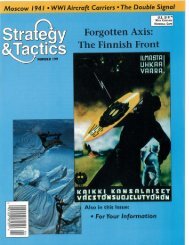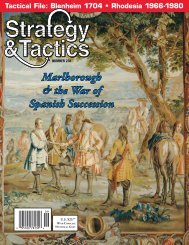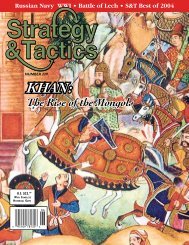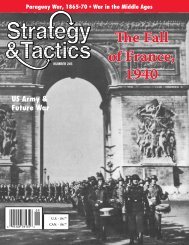the franco-prussian war - Strategy & Tactics
the franco-prussian war - Strategy & Tactics
the franco-prussian war - Strategy & Tactics
You also want an ePaper? Increase the reach of your titles
YUMPU automatically turns print PDFs into web optimized ePapers that Google loves.
This game represents some effort in assembling anorder of battle, assigning combat factors, androughly designing a battlefield, but <strong>the</strong> rules areterribly inadequate and players will, on <strong>the</strong> whole,have to figure out <strong>the</strong>ir own.018a. Pharsalus (1972, order from ADA, $1 50). byStuart Schoenberger, deals with <strong>the</strong> battle of 48 B.C.in Greece between Caesar and Pompey in whichPompey was decisively defeated. The treatment isvery much <strong>the</strong> same as that of Granicus: a 30 squareby 30 square map is roughed out and an order ofbattle with combat factors is provided, but not actualmap or unit counters. Pharsalus has many more unitsthan Granicus: Pompey has 112 combat units andCaesar 42. There is a great disparity of force between<strong>the</strong> two sides, but some of Pompey's troops may bedropped to balance <strong>the</strong> game. The rules are morecomplicated but also even more incomprehensible.The combat system is very much like that of <strong>the</strong>standard Napoleon at Waterloo 1046). The ADArecommends with this as with several of <strong>the</strong>irofferings, "Buy this game if you want to know hownot to design a game."018b. Thapsus (1972, order from ADA, $1.50). byStuart Schoenberger, deals with <strong>the</strong> battle betweenCaesar and <strong>the</strong> Senatorial forces in North Africa in 46B.C. It was Caesar's last battle. It is done in <strong>the</strong> sameoutline fashion as <strong>the</strong> o<strong>the</strong>r two (018 and 018a), butsince <strong>the</strong> game is more complex, <strong>the</strong> problems arecompounded several times. The map is suggested,but since <strong>the</strong> terrain is very complex, it is quiteuncertain how to make <strong>the</strong> board. Caesar has over100 beginning units, some of which can be brokendown somehow according to extremely unclearrules. The Senatorial Forces have only about 80 unitsbut also have <strong>the</strong> benefit of walls of Thaosus. The-game involves naval forces and siege units as well asland combat, but all is described in a set of rules thatare truly remarkable for <strong>the</strong>ir disorganized incomprehensibility.Again, ADA recommends, "Buy thisgame if you want to know how not to design0 n0mP "~ . ~ - ~ -019. Decline and Fall (2nd edition, 1972, WRG,$9.50 including postage by surface mail), by TerrenceP. Donnelly, is basically <strong>the</strong> same game reviewed inMOVES #4 lp. 14, 015). The main changes arephysical: <strong>the</strong> board is now mounted and printed infour splendid colors; <strong>the</strong> counters are laminatedcardboard, already cut and with attractive symbolsand colors, and <strong>the</strong> whole is in a box (too weak a boxas yet, but <strong>the</strong> publishers are attempting to get newones). The game is still an excellent and historicallyinformative game for four people who must combine<strong>war</strong>game skills and diplomatic skills to survive or towin. Some changes in <strong>the</strong> rules have been made:ambiguities in <strong>the</strong> sea movement rule have beenresolved with an example of such movement; <strong>the</strong>conflict resolution table has been altered slightly; <strong>the</strong>retreat after combat rule has been changed to makeit more unlikely than before that an enemy piece canbe destroyed by forcing it into an unfriendly zone ofcontrol. A few new optional rules are added whichwould have <strong>the</strong> effect of increasing <strong>the</strong> eventfulnessof <strong>the</strong> game and its element of chance. The gameshould still have a strong appeal to historians,<strong>war</strong>gamers, Diplomacy players, and admirers ofgames which are fairly simple in <strong>the</strong>ir mechanics butcapable of a wide variety and sophistication in play.032. Breitenfeld (1972. order from ADA, $1.50, byStuart Schoenberger, deals with <strong>the</strong> decisive battlewith which Gustavus Adolphus of Sweden burst into<strong>the</strong> Thirty Years' War. It is not to be confused withano<strong>the</strong>r game of <strong>the</strong> same name and subject (S8TGuide no. 1,032). Like <strong>the</strong> o<strong>the</strong>r games in this series,this comes without board or counters but with roughinstructions for making both. There is nothing wrongwith <strong>the</strong> idea of a do-it-yourself game, but this is avery bad example of that idea. The sellers, <strong>the</strong> ADA,confess, on <strong>the</strong>ir list, "Buy this game if you want toknow how not to design a game," and that is <strong>the</strong>truth. The rules are unbelievably vague, incompleteand ungrammatical. There is very little attempt toreflect <strong>the</strong> <strong>war</strong>fare of <strong>the</strong> period and <strong>the</strong> wholepackage of 5 typewritten and duplicated pages isfantastically overpriced.033. Musket and Pike: Tactical Combat, 1550-1680(1973, SPI, $7.00), by John M. Young, graphics byRedmond A. Simonsen and Manfred F. Milkuhn,deals with <strong>the</strong> tactics of <strong>the</strong> period including <strong>the</strong> CivilWars in France and England, <strong>the</strong> Revolt of <strong>the</strong>Ne<strong>the</strong>rlands and <strong>the</strong> Thirty Years' War. It was aperiod of great confusion in tactics because of <strong>the</strong>incompatibility of <strong>the</strong> two main infantry weapons,<strong>the</strong> musket and <strong>the</strong> pike. The soldiers of <strong>the</strong> timefound that both were unnecessary, but constantlystrained to find a tactical system which wouldcombine <strong>the</strong>m without destroying <strong>the</strong>value of one or<strong>the</strong> o<strong>the</strong>r. This dilemma is neatly reflected in <strong>the</strong>stacking and o<strong>the</strong>r rules of this game. You can mix<strong>the</strong> two kinds of units this way, but no matter whatyou do it will be wrong. The game also shows <strong>the</strong>power and weakness of pistol wielding cavalry, but itprobably gives <strong>the</strong> Swedish cavalry a little too muchpower. The game is smooth and simple to operate,<strong>the</strong> map is not overly cluttered with terrain. The rulespresent few difficulties with one major exception: <strong>the</strong>optional (but really necessary) rule for using infantrysquares is nearly useless. There are 18 variedscenarios. There has been an attempt to describe <strong>the</strong>tendency of each scenario as favoring one side or <strong>the</strong>o<strong>the</strong>r or being evenly balanced, but I found <strong>the</strong>sepredictions to be very dubious. Never<strong>the</strong>less, it is afine and valuable interpretation of <strong>the</strong> <strong>war</strong>fare of.<strong>the</strong> period. [Note: The above was written before Ireceived <strong>the</strong> errata sheet for <strong>the</strong> game. The sheetclears up several things including <strong>the</strong> squareformation rule.]037. American Revolution (1972, SPI, $7.00). byJames F. Dunnigan, graphics by Redmond A.Simonsen, is a game of grand strategy dealing with<strong>the</strong> entire <strong>war</strong>, four moves to a year, from Spring1775 to Winter 1783. The total is 32 moves. Thecounters represent Continental or Militia forces for<strong>the</strong> Americans and Regular and Tory forces for <strong>the</strong>British. This loses many distinctions. Cavalry andartillery are averaged in with <strong>the</strong> infantry. Hessiansare subsumed into <strong>the</strong> British regulars. The map isdivided into movement areas with some designatedas wilderness which is more difficult to move into.especially for <strong>the</strong> British. But rivers and lakes play ndpart in <strong>the</strong> game except as <strong>the</strong>y were used as <strong>the</strong>basis for designating areas. The map also containsregions (one to five movement areas each), fromwhich <strong>the</strong> American draws his recruits and which areworthy victory points to <strong>the</strong> occupier. The Britishplayer wins by occupying and holding, with ananti-militia garrison, 51 points worth of territory, i.e.,Canada and a little over half of <strong>the</strong> 13 states orcolonies. There is a system for <strong>the</strong> entry of <strong>the</strong>French into <strong>the</strong> game after a major American victory.Meanwhile, <strong>the</strong> British, who have overwhelmingstrength during most of <strong>the</strong> game, are dependent onrolling good numbers on a die in order to move <strong>the</strong>ircounters according to any plan. The rules arerelatively simple and <strong>the</strong> game is easy to learn andplay. However, most of <strong>the</strong> task of <strong>the</strong> Americanplayer is ra<strong>the</strong>r dull, since most of <strong>the</strong> time <strong>the</strong> onlything he can do is get out of <strong>the</strong> way. So far, indeed,it appears that <strong>the</strong> American player has little chanceto win. It is possible for <strong>the</strong> British player to movecautiously so that he never takes any chances ofbeing attacked by <strong>the</strong> Americans, at least until verylate in <strong>the</strong> game. The only chance <strong>the</strong> Americanshave is to avoid all battles involving Continentals untilnear <strong>the</strong> end of <strong>the</strong> game.042b. 1812: The Campaign of Napoleon in Russia(Strategic Game) (1972, SPI, $12.00 with grandtactical game), by John Young and Phil Orbanes,graphics by Redmond A. Simonsen and Manfred F.Milkuhn, is an innovative, valuable and evenfascinating game on Napoleon's fateful invasion ofRussia. Unfortunately it does not quite work. Thereare several problems: Battles, for which a matrixsystem is used, are ei<strong>the</strong>r too potentially disastrousor too inclusive. Although <strong>the</strong> matrix system iscomplex, it still does not allow enough choices.Forced marches are much to chancy to be tried bymore than one or two units per game. Then <strong>the</strong>supply rules, when understood by <strong>the</strong> French player,work to his advantage. The French player can movehis units in groups of three corps anywhere in Russiawith a depot and supply unit and never suffer for lackof supplies, while <strong>the</strong> Russians do not have <strong>the</strong> depotunits to pull that trick. So <strong>the</strong> game becomes a puzzlewhich can be solved by <strong>the</strong> French player while <strong>the</strong>Russian player ei<strong>the</strong>r looks more or less helplessly onor tries a succession of desperate gambles in aneffort to stop <strong>the</strong> process. Most often <strong>the</strong> Frenchplayer will win with this relatively simple formula:fight no battles unless necessary; attempt no forcedmarches unless you are going to lose <strong>the</strong> unitanyway; concentrate enough to force Russians toconcentrate and deplete <strong>the</strong>ir supplies; <strong>the</strong>n marchthrough depleted Russia with expeditionary forces ofthree corps each; do not try to take Moscow; justtake everything else. These remarks, of course, referonly to <strong>the</strong>campaign game (Scenario 1). Scenarios 2and 3 start after <strong>the</strong> French have made mistakes.Thus, in Scenario 3, <strong>the</strong> French situation isimpossible, while Scenario 2 might be <strong>the</strong> closest to abalanced game.042c. 1812: The Campaign of Napoleon in Russia(Grand Tactical Game) (1972, SPI, $12.00 withstrategic game), by John Young and Phil Orbanes,graphics by Redmond A. Simonsen and ManfredMilkuhn, is <strong>the</strong> companion of <strong>the</strong> o<strong>the</strong>r 1812, but isbased on <strong>the</strong> veteran Leipza system for marchingand fighting. This allows a little more freedom inforced marching than <strong>the</strong> strategic version and muchmore certainty in battles. Now <strong>the</strong> French player canseek a battle with more confidence while <strong>the</strong> Russianwill avoid all clashes with <strong>the</strong> French main force. Thesupply and several o<strong>the</strong>r rules are virtually <strong>the</strong> samefor this version as for <strong>the</strong> strategic. Thus small forcesof French troops can march around with depots andsupply units without suffering while <strong>the</strong> Russianarmy gets progressively worse off. Again <strong>the</strong>re arethree situations or scenarios with <strong>the</strong> game: Scenario1 (<strong>the</strong> campaign game), heavily favoring <strong>the</strong> French;Scenario 3 (with <strong>the</strong> French beginning in Moscow)virtually assuring <strong>the</strong>ir destruction; and Scenario 2being a little closer to a balanced game.0453. Waterloo 1 (1971, ADA, $1.00). by StephenMarsland, is not to be confused with Waterloo 1(045). and is not recommended even by its author. Itdoes not attempt to deal with <strong>the</strong> actual battle ofWaterloo. Instead; it is supposed to represent <strong>the</strong>conditions of <strong>war</strong>fare of <strong>the</strong> period in a situation thatis vaguely reminiscent of Waterloo but is made up.The game is very poor physically. The unmounted,uncut, typed and hand-drawn counter sheet is alsopoorly colored and needs to be nearly all recopied.The mapsheet is small and unattractive but usuable.The rules contain several unnecessary complexitiesbut are for a basically simple game with fewdifferences among <strong>the</strong> three arms.048. Napoleon (1972, ADA, $4.00), by StephenMarsland, is a hypo<strong>the</strong>tical situation reflectingNapoleonic <strong>war</strong>fare on <strong>the</strong> grand tactical level. Theunits are infantry and cavalry divisions and artilleryunits; <strong>the</strong> French player chooses from among 41possible units, <strong>the</strong> Austrian from among 28 units.The mapboard represents "someplace" in Germanyapparently, but <strong>the</strong> hypo<strong>the</strong>tical scale is notannounced. Basic movement for French infantry is 4hexes for a two-hour move. The game is quitecomplex so it is fortunate that <strong>the</strong>re are relatively fewunits. It would be much better to operate <strong>the</strong> gamewith an umpire, although <strong>the</strong> rules are written in <strong>the</strong>assumption that <strong>the</strong> game will be played by twopersons who are not only scrupulously honest, butalso painstaking in <strong>the</strong>ir bookkeeping. Bookkeepingcomes from complex movement and combat rules.The counters on <strong>the</strong> board ordinarily are "strategiccounters" which represent up to 9 divisions. They aremoved only according to orders that have to bewritten one turn before <strong>the</strong>y start to take effect.When opposing strategic counters meet, <strong>the</strong>y areremoved and <strong>the</strong>ir constituent units are deployed on<strong>the</strong> board according to simultaneously writteninstructions. The Combat Results Table uses twodice and has eight different possible results, some ofwhich are combined. Then <strong>the</strong> results have to bekept track of for three or six phases. Victory is basedon a complex point system. The game is certainly notfor everyone. It is well-thought out and subtle. It hasnumerous difficulties in its innovative rules, but itoffers command problems not met with in morepopular games. Physically, <strong>the</strong> game is uninteresting,with a hand drawn map on an SPI hex sheet, spiritduplicated rules, and crudely drawn countersmounted on uncut cardboard. But is a valuablesimulation of some aspects of Napoleonic <strong>war</strong>fare.







